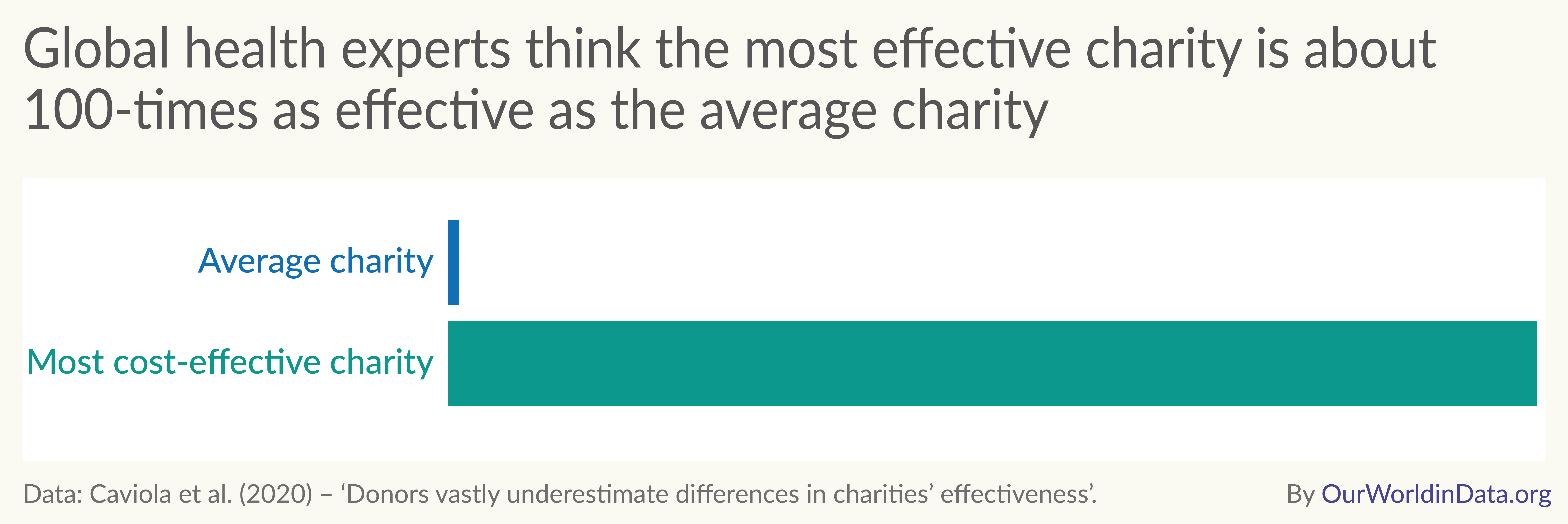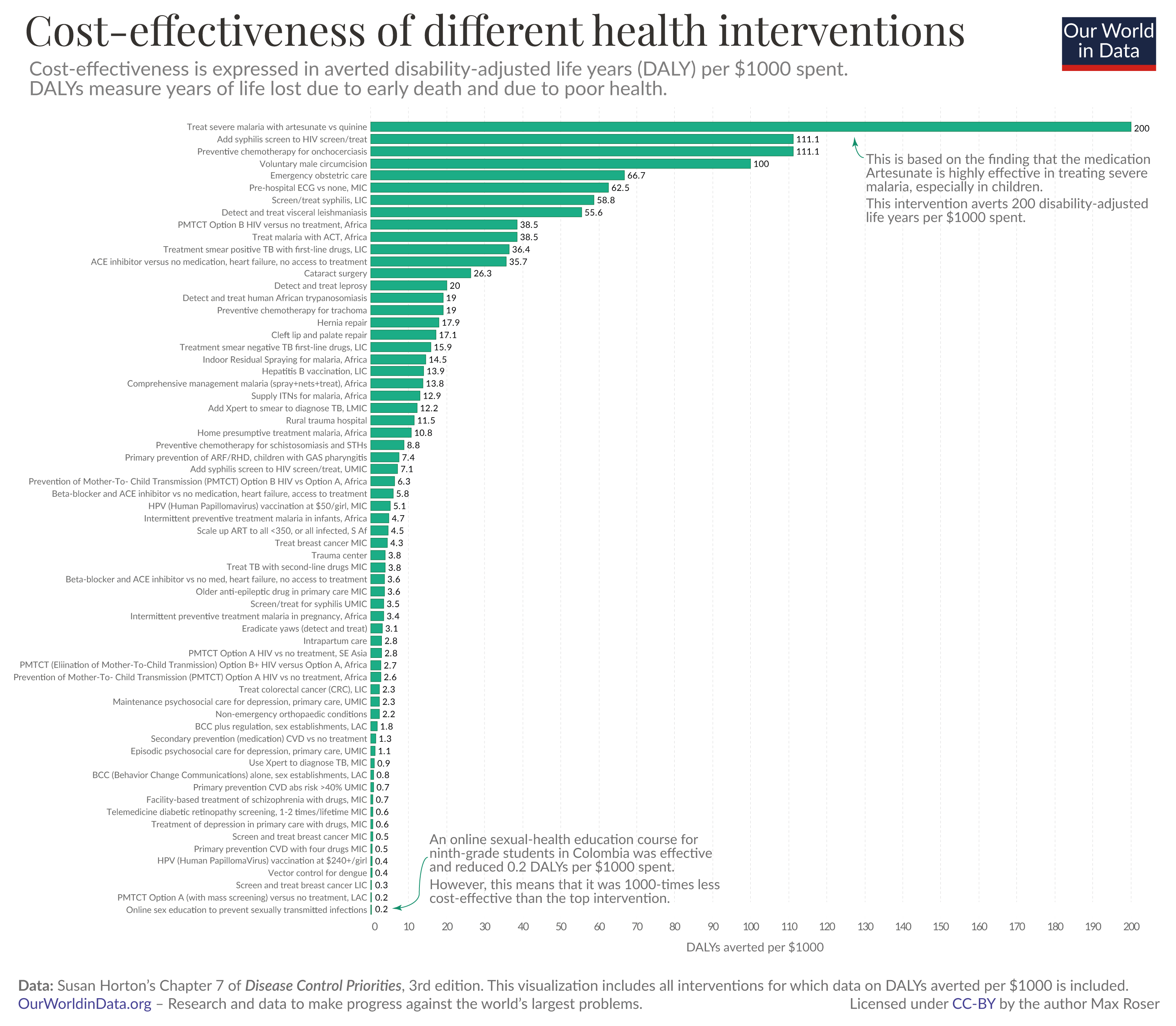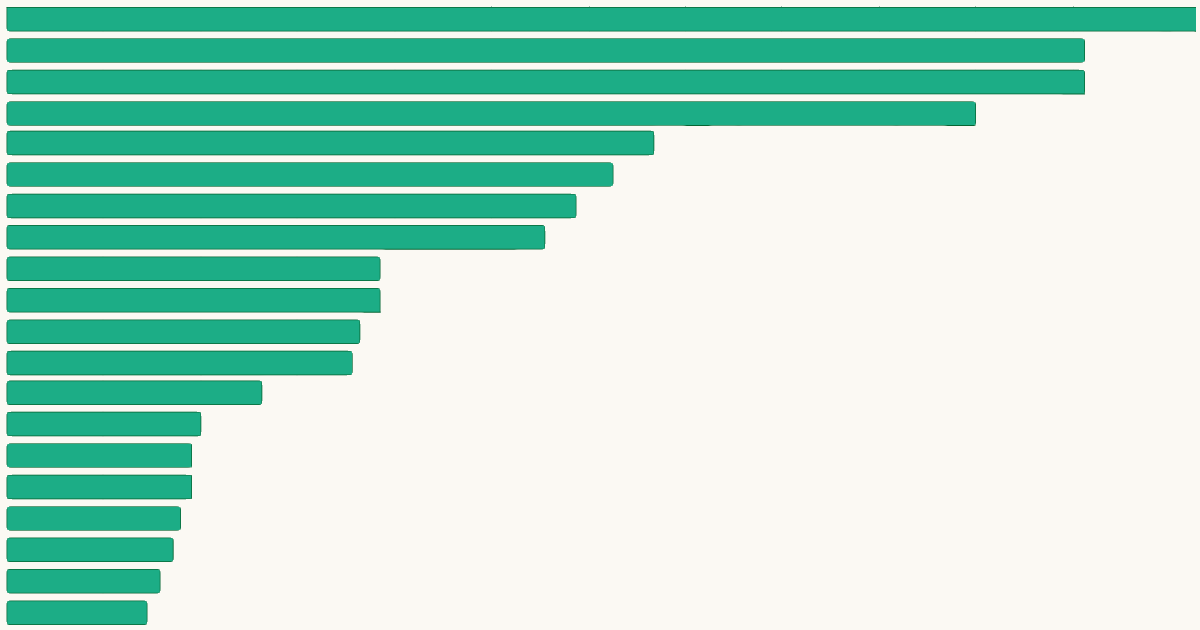There are many ways to improve the world, but their cost-effectiveness varies immensely. You can achieve a lot more if you rely on the best data on where to donate.
Giving money to a charity is one of the best things you can do for others. As we will see, your donation can make a huge difference.
But whether or not your donation makes a difference greatly depends on where you donate. If you give your money to the least cost-effective charities, it will not do much. If you give it to an exceptionally effective charity, the same amount of money can save someone’s life.
We all feel that some charities are more effective than others, but, as we will see, we tend to underestimate just how large the differences are. I will present the data on these differences and make the point that once you know them, the question of where to donate becomes morally crucial.
One reason life expectancy in the world’s richest countries is three decades longer than in the poorest countries is that they can spend much more on people’s health. Most interventions that improve people’s health — medical checks, medication, public health measures, surgeries — cost money.
For example, in the United Kingdom, the government is typically willing to spend up to about one million dollars to save a life.1 Many of us know people who would not be alive without costly treatment. Giving someone some more years to live is, of course, a fantastic way to spend money.
The share of people who donate some of their money has increased strongly in recent years. Asked whether they had donated last month, 37% answered yes in a global survey in 2023.2 In many countries, the majority donate some of their money — 61% donated in the United States, 67% in the UK, and 90% of people in Indonesia.
The total sum donated in the US was 530 billion dollars in 2022. This means the average American adult donated $2,000.3
Many of the charities that receive this money aim to improve people’s health. What do they achieve with these donations?
It’s clear to all of us that there is some variation across charities — some charities do a little worse, others do a bit better. Researchers Lucius Caviola, Stefan Schubert, and colleagues asked people how large they thought this difference to be among charities that help the world’s poorest people. They found that, on average, people believed the most effective charity to be about 1.5 times as effective as the average charity.4
The chart illustrates this perception.
To make it more memorable, let’s give these charities names. I’ll call the average charity the Good Charity, and since the top charity is even better, I’ll call it the Extraordinary Charity. For example, a 1.5-fold difference between them would mean that one million dollars given to the Good Charity would save two lives, compared to three lives for the Extraordinary Charity.
Now, the point of my article is that this perception is very far from reality.
The reality of our world is much more extreme. The difference between the average and the top charity is much larger.
In the same study, Caviola and colleagues contrast the perception of laypeople and experts in global health and charity evaluation.5 According to these experts, the difference between the average and most cost-effective charities is 100-fold, as shown in the next chart.
In the earlier example, I said the Good Charity can save two lives with one million dollars. If the ratio is 100-fold, the Extraordinary Charity could save two hundred lives with a million dollars.

Are the experts right? What does the actual data look like?
No complete dataset details the cost-effectiveness of all the world’s charities. However, plenty of good data exists on various health interventions. This data confirms that the differences across them are very, very large. At the end of the article, I reference evidence that brings together many such cost-effectiveness comparisons. Whether it is about social policy, educational interventions, or measures to reduce greenhouse gas emissions — dataset after dataset, we see very large differences across the various available options.
Here, I want to show you one of these comparisons. This is arguably the highest quality comparison that the world has. This data comes from a study called DCP3, a large global health study produced by more than 500 experts and published in nine volumes.6 For this article, I created a visualization of all cost-effectiveness estimates included in this study. You can find the details on each intervention in the DCP3 study; the point here is to see the large differences between them.
This dataset of interventions differs from a representative dataset as it is a sample of interventions that are all effective. Unfortunately, in the real world, this is not the case — governments and charities sometimes pay for health interventions that are known to be ineffective.7
Given that it is a sample of high-quality studies of health interventions that are all effective, these very large differences across health interventions are, therefore, particularly striking.

The true differences between alternatives are likely even higher than such comparisons suggest. This is because this overview only compares health interventions that are relatively easy to measure. Beyond these, there are likely charities that are even more cost-effective. One example is the work by agriculturalist Norman Borlaug, which was largely funded by charitable organizations. By improving agricultural yields, he contributed to the historical reduction of global hunger and is credited with saving the lives of dozens of millions of people; this source claims that he saved about 245 million lives. Such exceptional charitable work can, at times, be extraordinarily cost-effective.
Of course, this data is hugely important for those who donate money to charities. If we can find charities that implement the most cost-effective health interventions, we can achieve much more with our money.
Several meta-charities called “charity evaluators” have solved the practical problem of finding these charities.
This field saw a revolution in recent years, and I think it has been one of the most important trends in global development research. Before this revolution, there was a fierce debate about aid effectiveness, with some people strongly opposing it and others strongly supporting it. In the last decade, this heated debate has made space for a more clear-eyed approach that acknowledges that many charities are not effective at all while others are extraordinarily effective.8
The research teams at charity evaluators find that many charities are not very effective — and tragically, the very worst ones actually achieve the opposite of what they set out to do. Some people’s skepticism about charities has a foundation. But what charity skeptics overlook is that there are some outstanding charities at the other end of the spectrum. The best charities are extraordinarily effective and can do a lot with relatively little money.
At the start of this article, we saw that the UK is willing to spend about $1M to save a person’s life. What does the evidence look like for the most cost-effective charities in the world?
The charity evaluator that I have personally relied on over the past years for my own donations is called GiveWell. In 2024, GiveWell decided to support our work on Our World in Data with a grant; given that I consider them to be extraordinarily thorough in their evaluation of non-profits, I am particularly honored and proud that they decided to support our work.9
GiveWell found four charities that can save a child’s life for about $5,000 in donations.10
The four charities that achieve this level of cost-effectiveness do quite different things. One focuses on providing vitamin A supplements to children, the second provides seasonal medicine to protect children from malaria, the third distributes bednets to protect children from malaria, and the fourth incentivizes caregivers to give children their necessary vaccinations.
While they all do different things, they have two things in common. They all focus on the world’s poorest people, which makes sense as $1,000 makes a much larger difference to someone who has very little. They also all tend to focus on causes that don’t receive much public attention. That makes sense, too — for the causes that receive the most attention, all the lowest-hanging fruits have already been picked.
These charities are concrete, real-life examples of the Extraordinary Charity I mentioned at the start of my article.
The example I gave above — the difference between spending $1,000,000 to save a life in the UK and $5,000 to save a life with the world’s most cost-effective charity — is real. For $1M donated to the most cost-effective charities, we can expect to save the lives of 200 children.
This gives us an incredible opportunity to help others. I think spending a million dollars to save a person’s life in the UK is a very good way to spend money — but it’s fantastic that the best opportunities can do so much more.

What does all this mean for our own donations?
I think the data we’ve seen needs to be at the center of the ethical decisions we make in our lives.11 The fact that the best charities are much more cost-effective than the average ones is morally important.
Our resources are limited; we cannot do it all. We have to choose what we do with our limited means, and this data can help us tremendously. Giving to the Good Charity when you could give it to a 100 times more cost-effective Extraordinary Charity is a big mistake.
Or viewed more positively, if you give $1,000 to an Extraordinary Charity, you can achieve more than someone who gives $90,000 to a Good Charity.
The best charities are not just a bit better than the average ones but way, way, way better. For anyone wanting to make the world a better place, I believe this is one of the most important facts to know about the world. This is so important to take in because it goes strongly against our intuition — we’ve seen above that most people think the best charities are about 50% better than average — and because it is morally important for the limited resources that we have in our lives.
You have a great opportunity right in front of you. Many people in high-income countries have the chance to give away $5,000. Perhaps not in one moment, but it is possible for many over a longer period.
Saving a child’s life is certainly something that everybody can be extremely proud of. Guided by research on differences in cost-effectiveness, many people can do this.
More data on differences in cost-effectiveness:
In the article, I focused on health interventions. However, very large differences in cost-effectiveness exist in many other policy areas. Benjamin Todd wrote a great overview article, combining datasets from many fields. It includes datasets on social policies, educational interventions, criminal justice policies, interventions to reduce greenhouse gas emissions, and more. Here is the article by Todd (2023): How much do solutions to social problems differ in their effectiveness? A collection of all the studies we could find.
Such differences also exist in other aspects of life. This suggests that we should often spend a lot of time thinking about what we want to do instead of doing whatever is most convenient or is right in front of us.
Acknowledgments: I would like to thank Edouard Mathieu for his helpful comments on drafts of this essay and the visualizations. I would also like to thank the authors of the cited study — Stefan Schubert and Lucius Caviola — for answering my questions and advising me on this article.
Explore more research and data on Our World in Data:
Child mortality: an everyday tragedy of enormous scale that we can make progress against
We live in a world in which 10 children die every minute.
Cite this work
Our articles and data visualizations rely on work from many different people and organizations. When citing this article, please also cite the underlying data sources. This article can be cited as:
Max Roser (2024) - “Many of us can save a child’s life, if we rely on the best data” Published online at OurWorldInData.org. Retrieved from: ' [Online Resource]BibTeX citation
@article{owid-many-us-can-save-childs-life-rely-best-data,
author = {Max Roser},
title = {Many of us can save a child’s life, if we rely on the best data},
journal = {Our World in Data},
year = {2024},
note = {
}Reuse this work freely
All visualizations, data, and code produced by Our World in Data are completely open access under the Creative Commons BY license. You have the permission to use, distribute, and reproduce these in any medium, provided the source and authors are credited.
The data produced by third parties and made available by Our World in Data is subject to the license terms from the original third-party authors. We will always indicate the original source of the data in our documentation, so you should always check the license of any such third-party data before use and redistribution.
All of our charts can be embedded in any site.
#save #childs #life #rely #data







